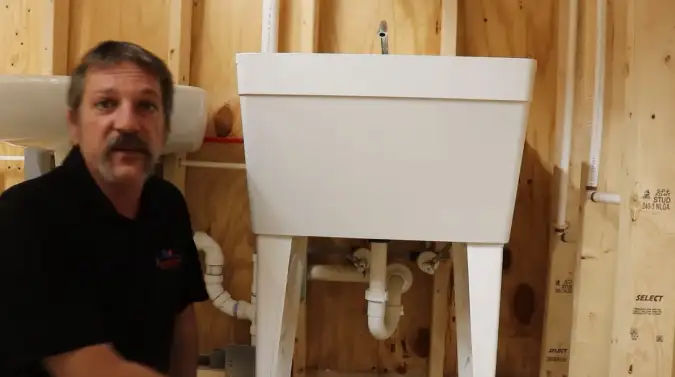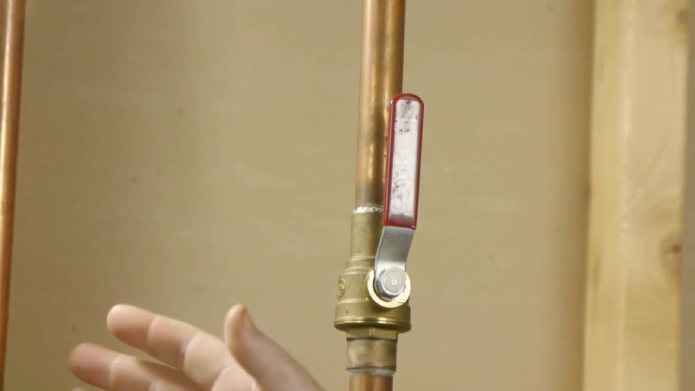Last Updated on May 7, 2023
You might want to think again if you plan to connect your sink drain to your sump pump. Generally, you can drain a sink into a sump pump, but it is not the most efficient or recommended method.
A sump pump is a powerful tool that can help protect your home from water damage and potential health hazards. It works wonders to keep unwelcome basement flooding at bay, but its job stops there. Don’t rely on it for sink drainage or any other type of wastewater. Doing so could cause costly clogging issues.
Also, sink water contains chemicals and detergents that can damage the sump pump or cause it to malfunction. Over time, the buildup of these chemicals and detergents can cause the pump’s motor to wear out, reducing its lifespan and effectiveness.
Don’t try to drain your sink into a sump pump. Find out the alternatives. We’ll deep-dive and explore why this isn’t recommended and what you can do instead.
Can You Drain a Sink into a Sump Pump: Why Not a Good Idea?

Though it may seem tempting, using a sump pump to drain your sink is not the way to go. From potential damage and clogging issues to serious safety risks, there are several reasons why you should avoid this solution at all costs.
1. Clogging
Draining a sink via a sump pump may seem like a convenient solution at first, but it can lead to various issues. One of the primary concerns is clogging.
The debris, food particles, and other waste that accumulate in the sink may also enter the sump pump, significantly reducing its efficiency.
A malfunctioning sump pump can lead to flooding and other water damage issues. So, avoiding draining your sink into your sump pump is crucial to prevent such problems.
2. Damage to the Pump
The chemicals and detergents in sink water can potentially cause significant damage to the sump pump. Many household cleaning products contain harsh chemicals that can corrode or damage the pump’s internal components.
Once the pump’s damage cannot be repaired, a costly replacement is necessary. This makes it clear why draining your sink’s water down a sump pump is not advisable.
3. Costly Repairs
As highlighted above, sink water damage or malfunction of the sump pump. When this happens, repairing the pump can become a costly affair.
The pump repair or replacement cost can quickly add up, especially if it occurs regularly. So, investing in a separate drainage system for the sink is essential to avoid such expenses.
4. Inadequate Drainage
Sump pumps are designed to handle specific types of waste, and sink water may not be one of them. While it may seem economical to drain sink waste water into a sump pump, it is not a sustainable solution.
The pump may not provide adequate drainage, leading to clogged drains and potential sewage backups. It is best to opt for a separate drainage system for sinks to avoid these failures.
5. Unsanitary

The use of sump pumps for draining sinks is not a good idea due to the unsanitary conditions that can result. Bacteria and other contaminants from the sink could be released into the environment or even your home if pumped out with a sump pump, leading to health issues for you and damage to both people’s property along with yours.
To avoid possible disaster, it is best to find alternative ways of properly dealing with that used-up dishwater.
6. Foul Odor
Another reason why pouring sink waste water down the drain is not recommended is the development of foul odors. Accumulated sink water may emit an unpleasant smell that can spread throughout the home.
This can be particularly concerning if the sink is located in a basement or other low-lying area. The buildup of organic matter and waste products can cause the sump pump to emit noxious fumes, making the space uninhabitable.
7. Reduced Efficiency
Putting a sink in the sump pump can also reduce its overall efficiency. Frequent pumping of the stagnant liquid will wear down the sump more quickly, resulting in costly and disruptive maintenance needs.
Even worse, it could hamper performance when floodwaters threaten. Don’t let that happen. Take control now with proper draining habits and keep those waters at bay while saving time and money.
8. Increased Risk of Flooding
Draining your sink with a sump pump can increase the risk of flooding in the event of heavy rainfall or other water sources. The sump pump may not be able to handle the additional load, leading to a backup of water in the basement or other areas.
This can cause significant damage to the home and can also be dangerous to inhabitants. So instead of draining sink water with a sump pump, look for alternative disposal options.
9. Higher Energy Bills
Draining sink water to a sump pump can also lead to higher energy bills. This is because the frequent use of the sump pump can cause it to consume more energy than necessary, leading to higher electricity bills.
With the additional strain on sump pumps, they may wear down faster than normal and need costly replacements or repairs. These can prove to be a major inconvenience, disrupting life’s daily routine in the worst way.
10. Water Damage

Overloading the sump pump with sink water can cause water damage to the basement or low-lying area. It’s especially dangerous if the sink’s in an area prone to flooding or other water sources.
The water damage can be extensive and costly to repair, leading to significant disruptions to daily life. As such, avoiding draining your sink with a sump pump is a good idea and instead seeking alternative disposal methods.
11. Maintenance Issues
The use of a sump pump to drain sink water may result in more maintenance issues than using it solely for its intended purpose. The additional debris and sediments from the sink water can cause clogging and backups to the pump, leading to decreased efficiency and expensive repairs.
Also, sink water can contain food particles and grease, which attracts rodents and insects, inviting further trouble. So, it is wise to avoid using a sump pump as a drainage outlet for sink water and to clean the pump regularly if used as such.
What Should You Do Instead of Draining Sink Water Through a Sump Pump?
Don’t be tempted to take the shortcut of connecting your sink directly to a sump pump. Instead, check out these alternative options for safely and smartly dealing with excess water.
1. Install a Sewage Ejector Pump
Rather than running a sink through a sump pump, you can opt to install a sewage ejector pump. This type of pump is made specifically to handle solid waste and wastewater from sinks, toilets, and other fixtures below the main sanitary sewer line.
It pumps the wastewater into the main sewer line, where it can be safely carried away. With this system in place, you won’t have to worry about clogged pipes, overflowing sewage, or health hazards often accompanying improper wastewater drainage.
2. Connect the Sink to the Main Sewer Line
If your sink is above the main sewer line, you can easily connect it to the line without using a sump pump. This option requires installing appropriate plumbing fixtures, allowing wastewater to flow directly into the main sewer line.
Doing this eliminates the need for mechanical devices, which increases the system’s efficiency and saves you both time and money in the long run.
Can a sump pump handle sewage?
A sump pump cannot handle sewage due to its inability to remove solid waste. If you plan to install a bathroom in the basement or have a home below the sewer line, you will need to use a sewage ejector pump in conjunction with your sump pump.
Sewage ejector pumps are specifically designed to handle solid waste and move it efficiently away from your home.
Attempting to use a sump pump to handle sewage can result in clogs, backups, and costly damages, making investing in a sewage ejector pump for these situations essential.
How Much Water Does a Sump Pump Remove?

The amount of water a sump pump can remove depends greatly on the horsepower (HP) and gallons per hour (GPH). A typical size is 1/3 HP, which has a capacity between 2000 to 3000 GPH.
But more powerful models with higher ratings exist that can move even larger volumes if needed. Just keep in mind other variables like the pit’s depth or how long it’s running must be considered when selecting one suitable for your specific requirements.
Does it make sense to drain a sink into a larger sump pit with two sump pumps?
After knowing the potential issues with dumping a sink down a sump pump, you may wonder whether two sump pumps with a larger pit can handle it. Still, it’s not recommended.
While draining a sink into a bigger sump pit with two pumps may eliminate inadequate drainage, there is still the risk of clogging.
Also, two sump pumps require extra energy to operate and generate more noise. Additionally, the additional waste may cause damage to the pump over time and can be difficult to clean out if it gets clogged.
So, it is best to avoid draining sink water into a larger pit equipped with two sump pumps. And install a sewage ejector pump or hook it up to the main sewer instead, which we discussed earlier.
Averting Disaster – Safely Direct Your Sink Water Away From Home Damage
Neglecting to take the proper steps when dealing with sink water could lead to clogs, damage and even potential health risks.
While a sump pump might seem like an easy fix for draining away wastewater from sinks, it’s definitely not advised. Because these pumps are simply not designed to handle such volumes or frequency of waste.
So, don’t be fooled by the potential convenience of disposing of your sink water via a sump pump. It could end up causing costly repairs and clogs.
Instead, invest in solutions like separate gravity drains or sewage ejector pumps to ensure your plumbing systems run optimally for years. Taking care of this now can save you from serious headaches in the future.



